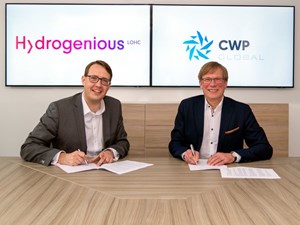News
CWP Global and Hydrogenious explore green H2 transport chain from Morocco to Europe
The renewable energy development company CWP Global and the German pioneer for liquid organic H2 carriers (LOHC), Hydrogenious LOHC Technologies, have signed a memorandum of understanding (MoU) for a joint feasibility study in 2023 that will explore a 500 tpd H2 transport chain from Morocco to Europe using Hydrogenious’ proven LOHC technology.
The 15-GW AMUN project near the city of Tan Tan in Morocco will be explored as a starting point in the feasibility study. This project is focused on producing ammonia locally from green H2, to support the decarbonization of fertilizer and maritime shipping, among others. In the interest of flexibility, safety and cost-efficiency, the partners have decided to also explore LOHC transport as an alternative allowing them to transport green H2 directly to Europe.
“We are very pleased to be partnering with Hydrogenious on this study that will serve to further explore the viability of LOHCs for long-distance shipping of green H2, using our 15-GW AMUN project as a model. This marks another step in building the clean energy future we are working towards, by identifying the most efficient and cost-effective solutions to deploying green H2 and its derivatives in support of net zero by 2050 goals,” said Guido Schumacher, Chief Technology Officer at CWP Global.
“CWP Global has a lot of experience in developing and implementing large-scale projects and we are very excited to be working with them,” said Dr Andreas Lehmann, Chief Strategy Officer at Hydrogenious LOHC Technologies. “Our collaboration on this feasibility study once again underlines the great strengths of our LOHC solution. As an option for storing and transporting H2 on an industrial scale, our LOHC technology has many advantages over other transport methods–particularly in terms of safety in urban areas or ports and the purity of the H2 achieved. We can also use the existing infrastructure for liquid fuels, further accelerating the development of the H2 value chain.”


